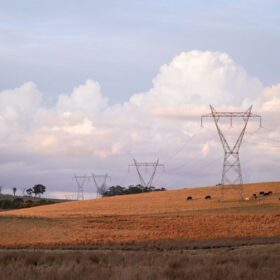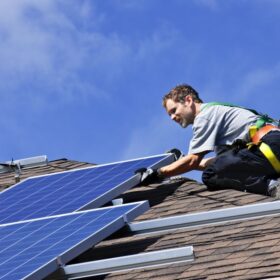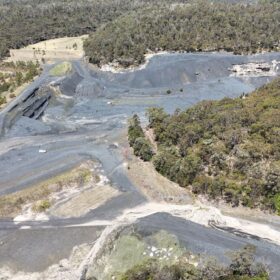The NSW Electric Vehicle Drive Day, led by the CEFC, is a chance to show fleet buyers why sales of EVs are gaining momentum around the world and encourage them to use their market influence tosuper charge Australia’s switch to EVs.
CEFC CEO Ian Learmonth said that fleet buyers could play an important role in helping Australia tackle one of its toughest emissions challenges – transport. Australia has some 19,000 businesses operating fleets with 20 vehicles or more, representing more than 2.1 million vehicles in total.
“Australians have traditionally been early adopters of new technology, but we have fallen behind the pack when it comes to EVs,” Mr Learmonth said. “Fleets buyers purchase as many as one in five new vehicles in Australia. We want to see EVs become their fleet vehicle of choice. It’s about using theirmarket power to influence the way we use our roads and the impact we have on our environment.”
Australia is the world’s 16th largest car market but ranks 21st in terms of new EVs sold, according to the 2019 EV Outlook from Bloomberg New Energy Finance. While there are about 9,100 EVs in Australia, this is 25 per cent lower than the much smaller New Zealand market.
Mr Learmonth added: “The reality is that we need to cut emissions right across our economy, from electricity to transport and more. Australians are already acting on electricity, with more and more of us putting solar PV on our rooftops. We can also have a big impact on emissions if we put electric vehicles in our garages, supported by charging infrastructure.
“In a smaller market like Australia, we know it will take time for more EV models to become available, and for prices to come down so EVs are more affordable for personal buyers. For fleet buyers, where driving needs are different, there is an opportunity for the EV transition to occur more quickly.”
Cars and light duty vehicles were responsible for 75 per cent of Australia’s total transport emissions of102 million tonnes in 2018, according to the National Greenhouse Gas Inventory. The data also shows that transport was the equal fastest growing sector for emissions (along with fugitive emissions) from 2000 to 2018, with continued growth expected to 2030.
Modelling produced for the CEFC and ARENA found that – with the right combination of incentives, models and infrastructure – EV sales in Australia could surge from as early as 2021. The Energeia report forecast that EVs could represent 90 per cent of all cars and light commercial vehicles by 2050, supported by $1.7 billion in investment in new public-access fast charging points.
The NSW EV Drive Day gives fleet buyers the chance to test the driving experience and performance of a range of vehicles and discuss vehicle operating considerations with manufacturers and industry experts.
It will showcase the latest range of battery EVs, plug in hybrids and hydrogen fuel cell EVs, across 16 models and 21 vehicles. More than 100 registered fleet managers and buyers will meet representatives from BMW, Hyundai, Jaguar, KIA, Mini, Mitsubishi, Nissan, Renault, SEA Electric, Tesla and Toyota.
Highlights include:
- − Toyota iRoad, a unique 3-wheeled, 2-seater EV (view here)
- − Remote self-parking fuel cell Hyundai (view here)
- − Woolworths electric delivery truck, built by Australia’s SEA Electric (View here)
- − Charging station demonstration by Jet Charge/Charge Fox
Mr Learmonth added: “Increasing the share of EVs on the road translates directly into lower emissions from fuel combustion. While EV charging will add to demand for electricity, emissions from vehicle charging will fall as we increase our share of renewables. By working with industry groups andother financiers, it’s clear that vehicle buyers want to see lower vehicle costs and more models to encourage them to switch to EVs. We hope that increased buyer interest in EVs from volume buyerssuch as fleet owners can encourage EV manufacturers to grow their share of the Australian market.”
The CEFC has financed more than 1,000 EVs via its co-finance programs with major banks and non- bank lenders. Together with its finance for lower emissions on-farm vehicles and equipment, the CEFC has invested more than $500 million in low emissions transport. The CEFC is also considering investments in EV charging infrastructure.
Through the Clean Energy Innovation Fund, the CEFC has also invested in two Australian companies at the forefront of the EV transition:
- − Relectrify is developing and commercialising control technology that unlocks extra performance in battery systems by boosting their second-life storage capability and lifespan once they are no longer effective as EV batteries.
− SEA Electric is converting medium-duty trucks and commercial vans into EVs, integrating and assembling EV drive train systems into a basic chassis and framework including the cab, fitted with the battery pack, electric motor, and other elements of the drive train.
The NSW EV Drive Day is organised by the CEFC, with support from Transport for NSW, the NRMA, the Australasian Fleet Management Association, Charge Together and JetCharge/Charge Fox.
NSW EV DRIVE DAY VEHICLES
*All vehicles available for pre-order/purchase in Australia (except for the Toyota iRoad)
MODEL | MOTOR TYPE | MODEL | MOTOR TYPE |
Tesla X | Electric | Mitsubishi Outlander | Plug in hybrid |
Tesla S | Electric | Renault Kangoo Z.E. | Electric |
BMW i3 | Electric | Renault ZOE | Electric |
MINI Countryman | Plug in hybrid | Kia Niro | Electric |
Hyundai IONIQ EV | Electric | Nissan LEAF | Electric |
Hyundai Kona EV | Electric | Toyota iRoad | Electric |
Hyundai Nexo | Fuel cell electric vehicle | Toyota Mirai | Fuel cell electric vehicle |
Jaguar I-PACE HSE | Electric | SEA Electric Truck | Electric |






By submitting this form you agree to pv magazine using your data for the purposes of publishing your comment.
Your personal data will only be disclosed or otherwise transmitted to third parties for the purposes of spam filtering or if this is necessary for technical maintenance of the website. Any other transfer to third parties will not take place unless this is justified on the basis of applicable data protection regulations or if pv magazine is legally obliged to do so.
You may revoke this consent at any time with effect for the future, in which case your personal data will be deleted immediately. Otherwise, your data will be deleted if pv magazine has processed your request or the purpose of data storage is fulfilled.
Further information on data privacy can be found in our Data Protection Policy.